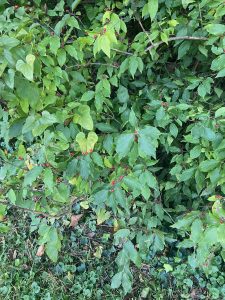
Different types of bushes are growing below the winterberry. Thes unknown leaves are heart-shaped
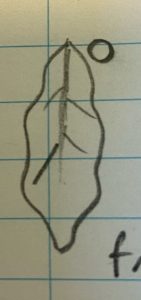
Here is a sketch of the leaves and the berry comparison to them.
For my species summary, I chose to identify a red berry bush. The bush is Northeast of my sit spot. I believe the berry bush is a common winterberry (Ilex verticillate). I chose this berry bush because when I first went to my sit spot to do this assignment, someone was sitting in my spot, so while I waited for them to leave, I saw this bush to the right of the entrance to my sit spot and saw that there were many more berries present there than from the view of my sit spot. The place I observed is about 5 yards from my actual sit spot, but I was still able to see the bush from where I sat.
I don’t know about you, but growing up I was always told to avoid anything that was red in the “wild” because that means its poisonous. Growing up always being in the outdoors, I was taught to not touch any strange trees or plants as they could be poisonous, so when I heard about writing a species summary, I decided to go straight to the red berry bush, because why not… right?
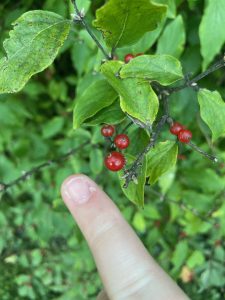
Here is a size comparison to my pinkie finger
Anyway, the leaves of the bush are oval shaped with pointed ends that weave in and out like waves along the edge. The leaves are fuzzy and soft, and don’t crumble in your hands as dry leaves would. The leaves are about 2 to 3 inches long and an inch wide. The leaves’ color ranges from a forest green color to an emerald green. The tops of the leaves are darker than the undersides. The berries on the bush are bright red, with a glossy looking skin. The berries themselves are no larger than the size of a pinkie fingernail. The bush itself is about 10 feet tall and 15 feet wide. The bush is acting as a barrier from the practice field to the creek, with an open area in the middle of the bush, acting as a small shelter. There are many smaller bushes growing under it, closer to the ground, with heart shaped leaves. I haven’t seen any animals coming and eating the berries at any of the times I have visited my sit spot, but I have seen many small insects sit on the leaves of the bush.
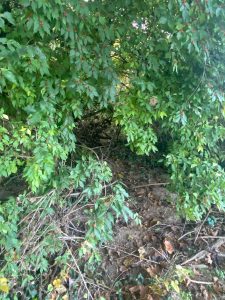
There is a little open patch of ground inside the bush to act as a small shelter for animals that are hiding from people or weather.
A winterberry bush can grow between 5 to 15 feet tall (U.S). The leaves are usually dark green in the summer and turn yellow in the fall, and fall from the bush by mid-October, which will be very soon (U.S.). These berries are dioecious, meaning the male and female reproductive organs are in separate individuals (U.S.). In order for these berries to reproduce, the male bush must be within 40 feet of a female bush (U.S.). This shrub acts a good provider of food for wildlife, but the berries of this bush are actually poisonous to humans (U.S.).
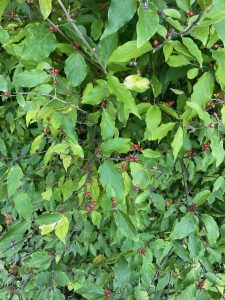
Different shades of leaves in the winterberry bush.
An interesting fact that I came across what that in Virginia, there are several different holly type bushes. The possum haw (Ilex decidua) is a related species found in the Coastal Plain, while mountain
holly (Ilex montana) is found in the mountain regions (Virginia). These two species are very similar to winterberry bushes but are more tree-like in their appearance (Virginia).
I found trying to identify my organism to be quite difficult, but in a fun way. There are many red berry bushes that look alike, only varying in the leaf type. I found the closest resembling berry bush I could find and, with the help of some classmates, was able to find a closely resembling berry bush. I first started looking up red berry bushes in Virginia and looked at images on google search to find three berry bushes that only varied slightly. After this, I dug deeper and used the USDA website to help classify my berry bush with much more detail.

A wide angle of part of the winterberry bush
Getting to go out and just try to write a detailed description of a bush, where others chose to write about animals, was boring at one point because I was beginning to run out of details to write and couldn’t get myself to think or see anything else about the bush. I got up and walked around the bush a few times to see if there was anything else about the bush that would make it stand out, but I didn’t have much success. I did enjoy investigating deeper into an organism’s background and try to identify it myself. Next time, I may wish to be able to watch insects or birds instead, but this was an overall positive learning experience that I will continue to try and do with other organisms.
References Cited:
U.S. Department of Agriculture (USDA). (2002, February 5). Plant Fact Sheet: Common Winterberry. Common Winterberry Ilex Verticillata (L.) Gray. https://plants.usda.gov/factsheet/pdf/fs_ilve.pdf
Virginia Department of Forestry. (2016, August). Common Native Shrub and Woody Vines of Virginia: Identification Guide 2016 Edition. Http://Www.Dof.Virginia.Gov/Infopubs/Native-Shrub-ID_2016_pub.Pdf. http://www.dof.virginia.gov/infopubs/Native-Shrub-ID_2016_pub.pdf

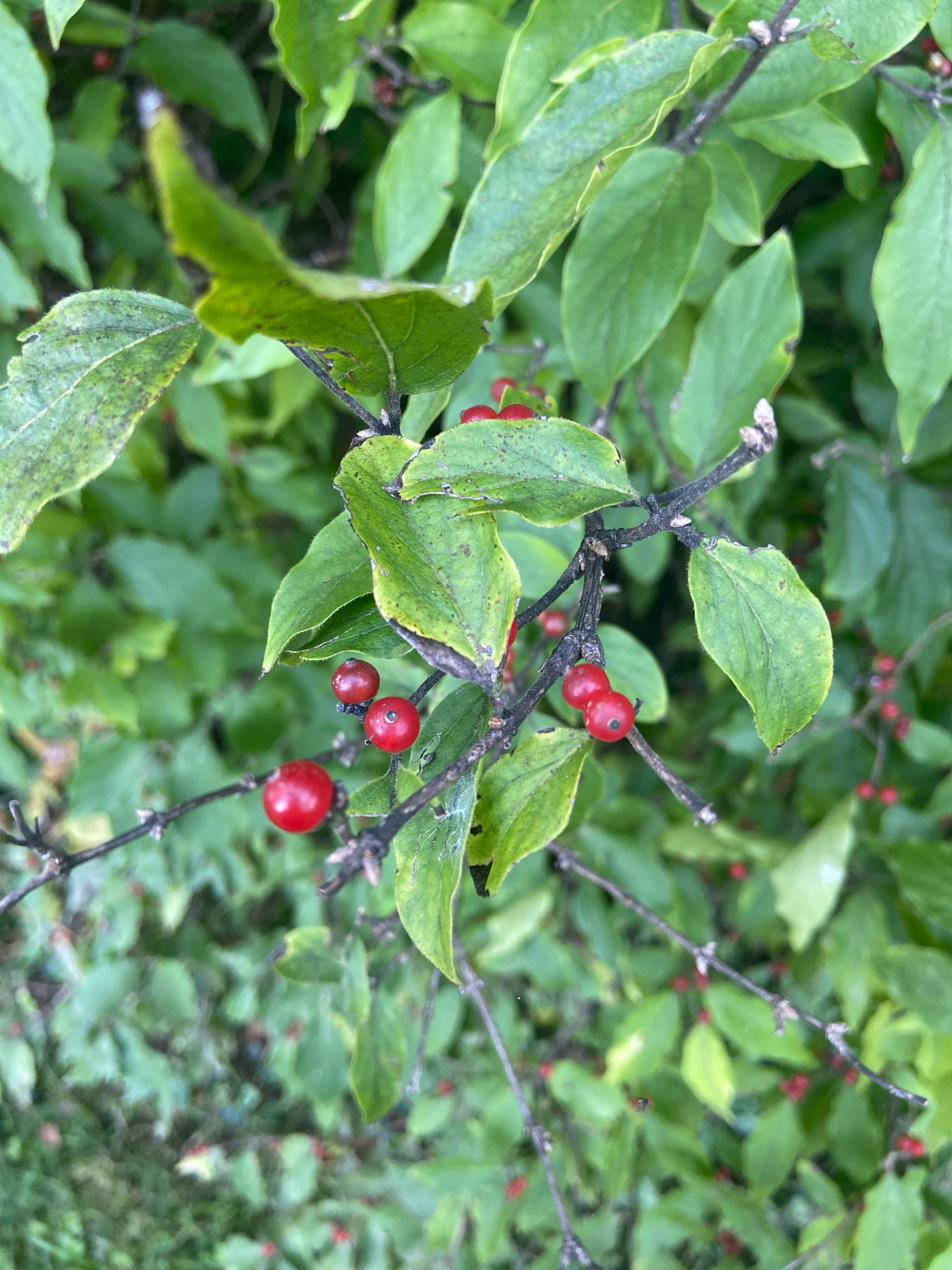
Hi, I really love the vibrant colors in the very first picture you included. I like that you chose the common winterberry because I have also heard that you shouldn’t touch red berries in fear of them being poisonous and I liked learning something new. I totally understand how identifying your organism could be difficult but I’m glad you thought the process was fun. I really enjoyed reading your blog post.
The layout of your post really helps with the overall flow of the discussion. The lessons you learn as a kid are the ones that stick with you the most, but they aren’t always like reality, but this time it did, very interesting. I also had a bit of trouble trying to identify the specific species since there are often very minute differences between those with the same genus.
This is such a cute plant! It is crazy to me that this is only toxic to us, but not most animals; I am also disappointed to know that it will be leaving so soon! I had no idea that these were poisonous (not that I typically go prodding plants and eating them when I’m bored) but it is still nice to be educated. I can totally get how it would be difficult to identify these; You are much more confident than I am because I would’ve taken forever to figure it out with a plant so simple!
I have also seen some of these bushes near the creek when wandering to CVS and was wondering what they were! It’s cool to finally know what they are, although I hadn’t planned on trying to taste test them anyways.
Hi, this is so descriptive! I love how you described the leaves and how you tried to find out exactly which red berry bush it was! I have a question though, you said in your blog that it was hard to identify your bush, and that the closest picture you found was that of the winterberry. Were there any other “close” resemblances in terms of leaf and berry type besides the winterberry?